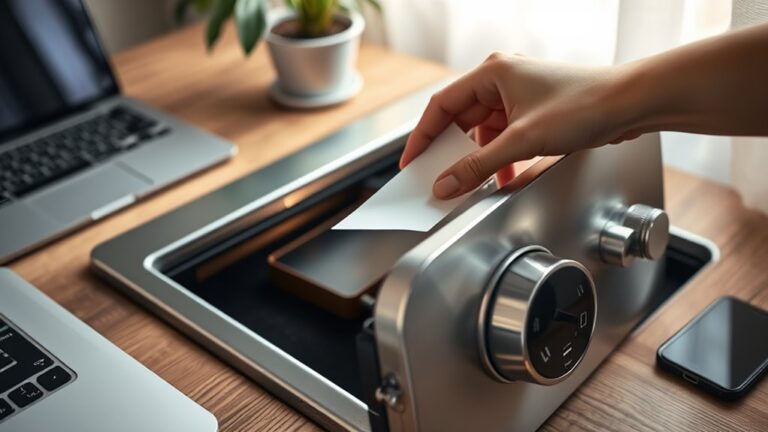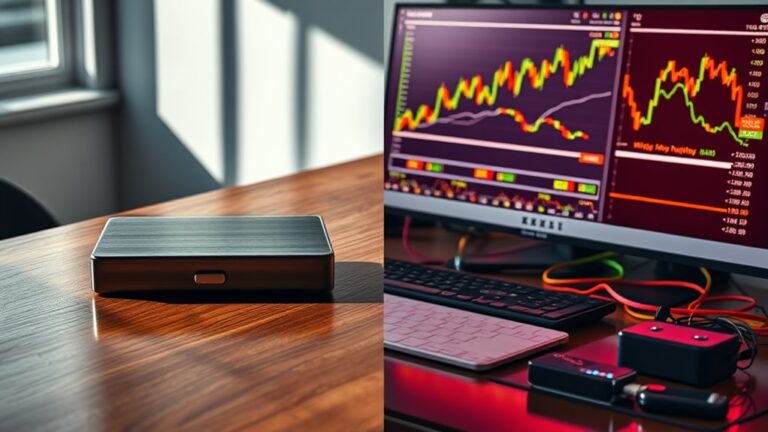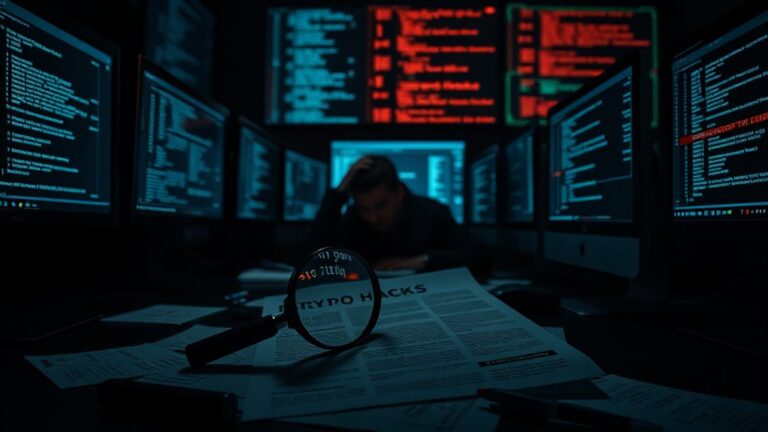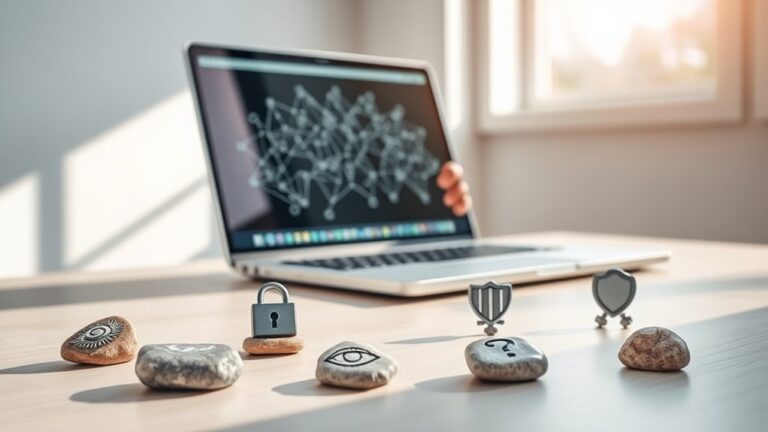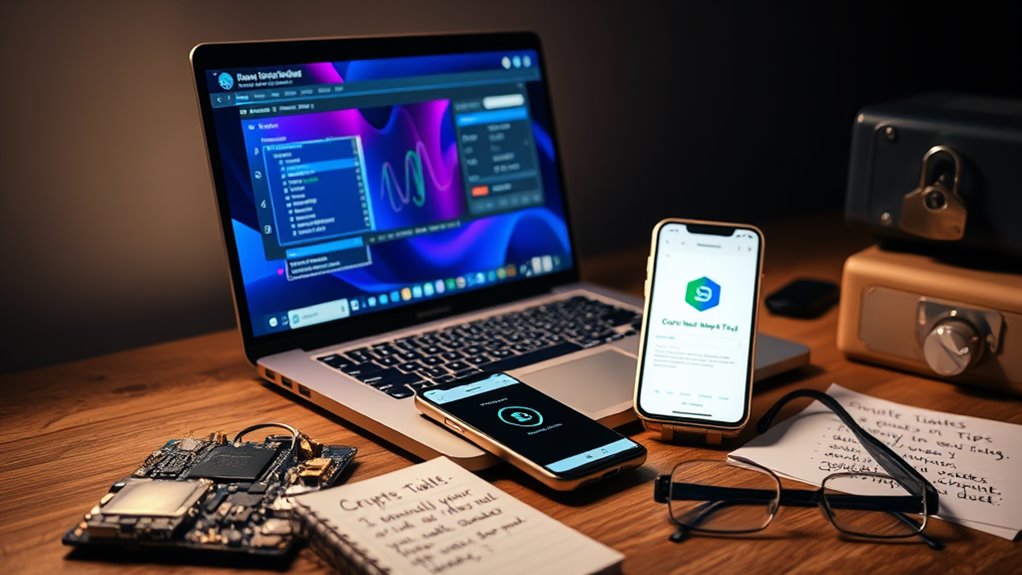
Crypto Security for Beginners: Top Safety Tips & Best Practices
Effective cryptocurrency security begins with selecting appropriate wallet types based on usage needs. Hot wallets serve daily transactions while cold storage protects larger holdings. Investors should safeguard private keys, enable two-factor authentication, and maintain secure backups of seed phrases. Avoiding common scams requires verifying exchange legitimacy, scrutinizing investment opportunities, and recognizing warning signs like anonymous developers or unrealistic promises. These fundamental practices form the foundation for safely traversing the cryptocurrency landscape.
Key Takeaways
- Use hardware wallets like Ledger or Trezor for significant holdings and keep software wallets updated for daily transactions.
- Secure private keys through cold storage, never share them online, and maintain multiple protected backups of seed phrases.
- Enable two-factor authentication on all cryptocurrency platforms to prevent unauthorized access and protect against phishing attempts.
- Research exchanges thoroughly, prioritizing those with proven security track records, regulatory compliance, and robust authentication measures.
- Verify project legitimacy before investing by checking team credentials, avoiding unrealistic promises, and being wary of artificial hype.
Understanding Crypto Wallet Types and Their Security Features
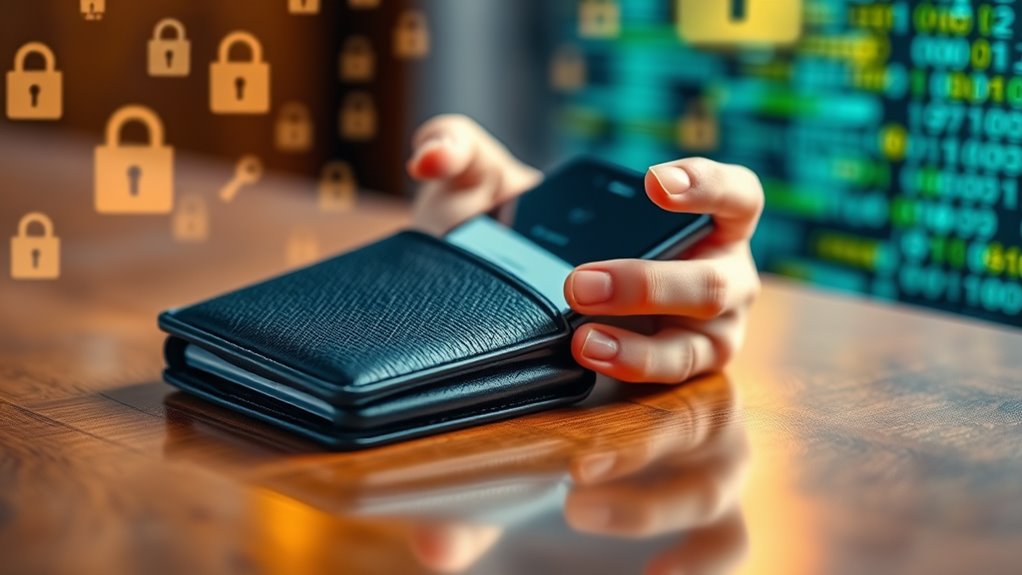
Nearly every cryptocurrency user faces an important decision when entering the digital asset space: selecting the right type of wallet.
Wallets broadly fall into custodial (managed by third parties) or non-custodial (user-managed) categories, with each offering different security profiles.
Hot wallets remain connected to the internet, providing convenience for frequent transactions but introducing vulnerability to cyber attacks. Examples include Mycelium and Coinbase Wallet.
Cold wallets, by contrast, store assets offline, considerably reducing hacking risks. Popular hardware options like Ledger and Trezor ($100-$200) store private keys on physical devices, offering enhanced security through offline storage and transaction signing capabilities.
For ideal security, experts recommend a balanced approach: using hot wallets for daily transactions while keeping larger holdings in cold storage, combined with regular software updates and secure backups. Additionally, it is crucial to keep sensitive information, like private keys and seed phrases, stored securely offline to protect against potential threats.
Protecting Your Private Keys: Essential Safety Measures
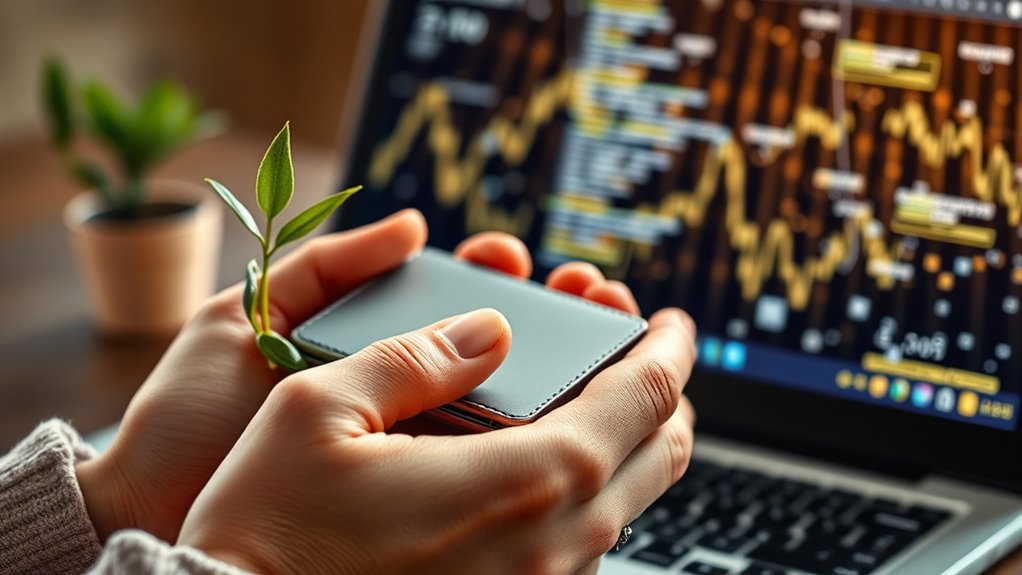
Private keys function as the ultimate proof of ownership in the cryptocurrency ecosystem, making their protection paramount for anyone holding digital assets. The most secure methods include hardware wallets, cold storage, and encrypted devices that keep keys completely offline, safe from potential online threats.
| Storage Method | Security Level | Best For |
|---|---|---|
| Hardware Wallet | Very High | Long-term holdings |
| Paper Wallet | High | Backup solution |
| Cold Storage | Very High | Large investments |
Implementing techniques like multi-signature authorization, key splitting using Shamir’s Secret Sharing, and strict access controls adds additional layers of protection. Regular security audits, using two-factor authentication, and maintaining awareness of phishing schemes are equally important. For maximum security, experts recommend combining physical storage solutions with robust digital protection measures. Additionally, utilizing trusted key management systems can greatly enhance the overall security of private key storage.
How to Choose a Secure Cryptocurrency Exchange
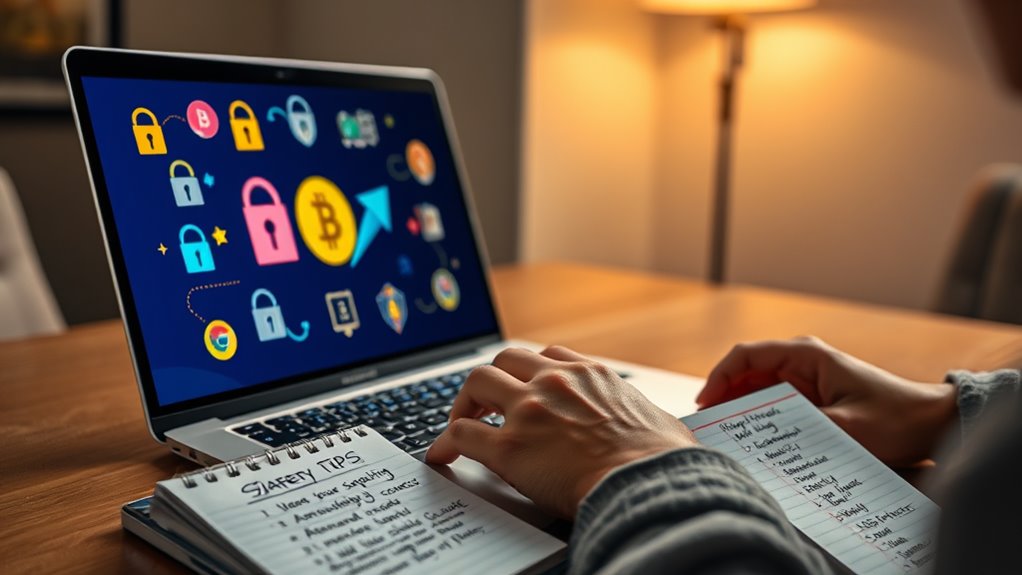
Selecting a cryptocurrency exchange requires careful assessment of its security features, including two-factor authentication, cold storage practices, and regular security audits.
The reputation of an exchange, evidenced through user reviews and its history of addressing security incidents, provides valuable insight into its reliability and trustworthiness.
When evaluating potential exchanges, newcomers should prioritize platforms that demonstrate both robust technical safeguards and a solid track record in the cryptocurrency community. Additionally, it is vital to consider exchanges that offer high liquidity, as this can greatly enhance trading efficiency and reduce slippage.
Security Features Matter
When choosing a cryptocurrency exchange, the security features implemented by the platform should be a top priority for investors. Exchanges with robust security measures protect users’ assets from potential threats while providing peace of mind during transactions.
- Multi-layered protection – Look for exchanges that implement two-factor authentication, advanced encryption techniques, and DDoS protection to safeguard accounts from unauthorized access and large-scale attacks.
- Cold storage solutions – Prioritize platforms that store the majority of user funds in offline wallets, disconnected from the internet, greatly reducing the risk of hacking attempts.
- Multi-signature technology – Exchanges that require multiple private keys for transaction authorization offer an additional security layer, ensuring that a single compromised key cannot lead to unauthorized fund transfers. Additionally, regular audits and penetration testing help ensure the exchange’s infrastructure remains secure and can proactively address vulnerabilities.
Reputation Speaks Volumes
Trust forms the foundation of any secure cryptocurrency exchange relationship, making an exchange’s reputation one of the most critical factors for investors to evaluate. When researching platforms, look for exchanges registered with governmental authorities and those following strict AML and KYC protocols.
An exchange’s history of compliance, transparency in operations, and longevity in the market can indicate reliability. Proof-of-reserves, clear fee structures, and publicly available audit reports demonstrate accountability. User reviews and community feedback provide valuable insights into real-world experiences.
When evaluating exchanges, consider their response to past security incidents and their ability to adapt to emerging threats. Platforms that undergo regular third-party security assessments and maintain responsive customer support typically offer greater security assurances for cryptocurrency investors. Additionally, ensure that the exchange has safeguards in place against common pitfalls to protect your investments.
The Importance of Two-Factor Authentication in Crypto
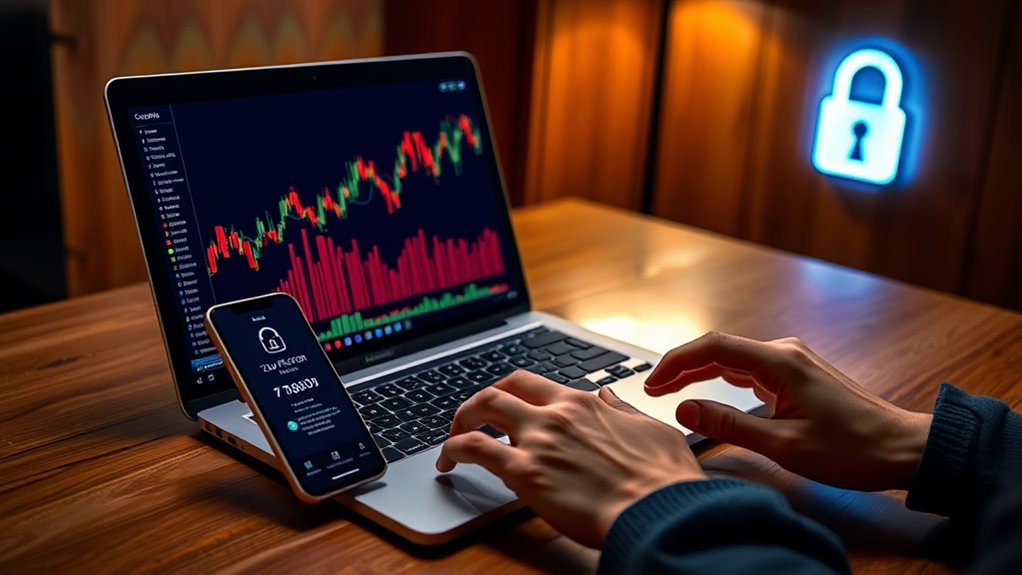
In today’s digital landscape, cryptocurrency security demands more robust protection than traditional financial systems due to the immutable nature of blockchain transactions.
Two-factor authentication (2FA) provides this essential layer of security by requiring a second verification method beyond passwords.
- Enhanced Security Layers – 2FA combines multiple authentication factors (knowledge, possession, or inherence), making unauthorized access considerably more difficult even if passwords are compromised.
- Protection Against Common Threats – When properly implemented, 2FA helps defend against phishing attempts, credential theft, and brute force attacks that frequently target crypto users.
- Recovery Options – Backup codes and alternative 2FA methods guarantee continued account access if primary authentication methods become unavailable, preventing permanent lockouts from valuable crypto assets.
- Irrecoverable Loss Prevention – Implementing 2FA is crucial because it helps safeguard against the risk of stolen cryptocurrencies, which are often irrecoverable if accessed by unauthorized users.
Common Crypto Scams and How to Avoid Them
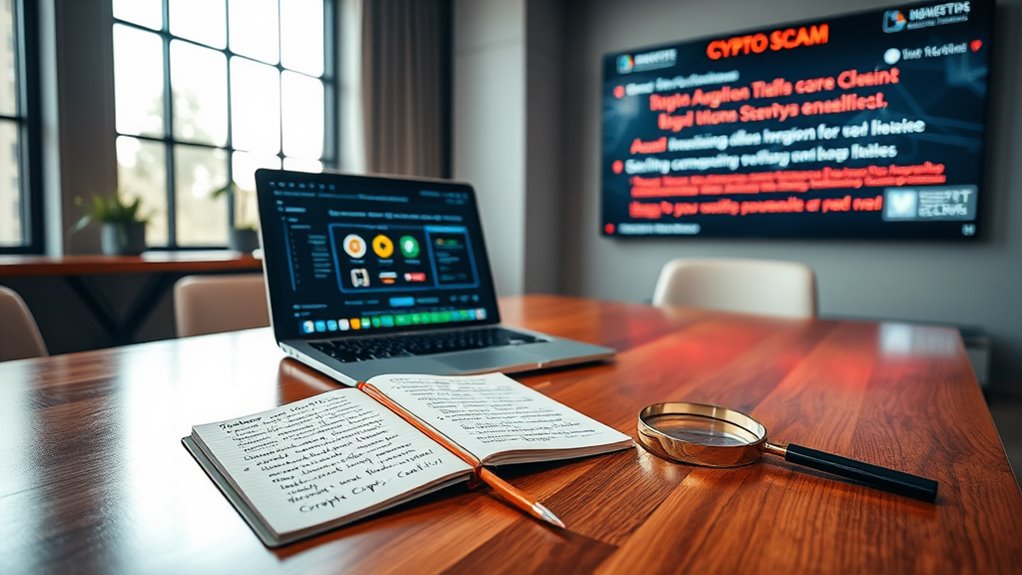
Cryptocurrency users face numerous scam tactics, including phishing schemes that mimic legitimate platforms to steal private keys and login credentials.
Traders should remain alert for pump-and-dump schemes where scammers artificially inflate a coin’s price through false information before selling their holdings at the peak, leaving others with devalued assets.
Prospective investors need to carefully examine Initial Coin Offerings (ICOs) by verifying team credentials, reviewing white papers, and checking for code transparency, as fraudulent projects often lack verifiable development history or present unrealistic promises of guaranteed returns. Additionally, investors should be cautious of rug pulls, where developers abandon projects and take off with investors’ funds, leaving them with worthless tokens.
Phishing Attack Prevention
As digital assets become increasingly valuable targets for cybercriminals, understanding how to prevent phishing attacks has become essential for anyone involved in cryptocurrency transactions.
Phishing scams in the crypto space range from spear phishing targeting specific individuals to pharming attacks that redirect users to fake websites.
To protect your crypto assets from these threats:
- Verify website URLs carefully – Check that you’re on legitimate sites before entering any credentials or wallet information.
- Enable multi-factor authentication (2FA) on all cryptocurrency platforms and wallets.
- Avoid clicking links in unexpected emails or messages, even if they appear to come from legitimate cryptocurrency services.
Additionally, staying informed about common types of phishing can help you recognize and avoid these scams. Using hardware wallets and keeping software updated further strengthens your defense against increasingly sophisticated phishing attempts.
Pump-and-Dump Scheme Detection
While protecting yourself from phishing attacks secures your existing assets, recognizing pump-and-dump schemes prevents you from making dangerous investments in the first place. These scams artificially inflate an asset’s price through excessive promotion before insiders sell their holdings, causing prices to crash.
| Warning Sign | What It Means | Action to Take |
|---|---|---|
| Sudden price spikes | Artificial inflation | Wait for stabilization |
| Anonymous developers | Lack of accountability | Research team credentials |
| Excessive social media hype | Manufactured FOMO | Verify independent sources |
| Unrealistic return promises | Too good to be true | Apply skeptical analysis |
| Limited project information | Hiding lack of substance | Demand transparency |
Always research cryptocurrencies thoroughly before investing. Check the project’s whitepaper, team qualifications, and listing status on reputable exchanges. Remember that legitimate projects focus on technology and utility rather than price speculation. Additionally, be aware of the massive hacks that have plagued the crypto space, which can indicate vulnerabilities in certain projects.
Fraudulent ICO Warnings
Initial Coin Offerings (ICOs) represent one of the most vulnerable areas for fraud in the cryptocurrency space.
Investors often face significant risks due to regulatory gaps and deceptive practices employed by scammers. Conducting thorough due diligence before investing is essential to avoid falling victim to these schemes.
When evaluating an ICO’s legitimacy, watch for these red flags:
- Lack of transparency about team members, goals, or how funds will be used
- Pressure tactics creating artificial urgency to invest without proper research
- Unrealistic promises of guaranteed high returns with minimal risk
Legitimate ICOs maintain strong community engagement, clearly outline risks, and comply with relevant regulations. Additionally, many ICOs provide a detailed whitepaper outlining the project’s vision, which is crucial for assessing their legitimacy.
Anonymous teams, celebrity endorsements, and excessive marketing should trigger caution, as these are common tactics used by fraudulent operations.
Creating a Comprehensive Backup Plan for Your Crypto Assets

Securing cryptocurrency assets requires a well-structured backup plan that protects against both digital and physical threats. Users should create multiple seed phrase backups using different methods, avoiding single points of failure.
Hardware wallets provide secure digital storage, while paper and metal backups offer protection against hacking but require physical safeguarding. For ultimate security, store backups in fireproof safes, bank deposit boxes, or other secure locations.
Physical seed phrase backups demand secure storage solutions like fireproof safes or bank deposit boxes to maintain protection against threats.
Never store seed phrases on computers, email, or cloud services, as these present significant hacking risks.
Regular maintenance guarantees long-term protection: verify backups periodically, keep firmware updated, and run anti-malware programs.
Advanced users might consider Shamir Secret Sharing or MPC technology to distribute backup responsibility across multiple secure locations.
Frequently Asked Questions
How Do Taxes Work for Cryptocurrency Investments?
Cryptocurrency investments generate tax liabilities when sold, traded, or used. Profits are subject to capital gains taxes based on holding period, while crypto earned through mining or staking is taxed as income.
What Legal Regulations Exist for Cryptocurrencies in Different Countries?
Cryptocurrency regulations vary considerably worldwide. Some countries ban crypto outright, like China, while others implement frameworks regulating exchanges, taxation, and anti-money laundering measures. The EU’s MiCA and Brazil’s Crypto Act represent emerging regulatory approaches.
Can Cryptocurrency Transactions Be Traced by Government Authorities?
Yes, government authorities can trace cryptocurrency transactions through blockchain’s public ledger, specialized analytics tools, exchange-provided data, and KYC protocols. While challenging, regulations increasingly require exchanges to report transaction information for monitoring purposes.
How Does Cryptocurrency Mining Affect Environmental Sustainability?
Cryptocurrency mining consumes significant energy, primarily from fossil fuels, generating substantial carbon emissions and e-waste. This creates environmental challenges including air pollution and health risks for communities near mining operations worldwide.
What Happens to My Crypto Assets if the Exchange Goes Bankrupt?
Like sheep without a shepherd, crypto assets on a bankrupt exchange face uncertain fates. Customers typically become unsecured creditors, often waiting years for partial recovery while assets remain frozen during bankruptcy proceedings.
Conclusion
Securing cryptocurrency assets requires consistent vigilance and application of best practices. According to a 2022 Chainalysis report, over $3.2 billion in cryptocurrency was stolen through various attacks, highlighting the critical importance of implementing multiple security layers. By understanding wallet options, protecting private keys, selecting reputable exchanges, using two-factor authentication, recognizing common scams, and maintaining thorough backups, investors can considerably reduce their vulnerability to theft and fraud.


